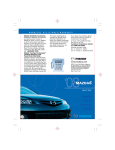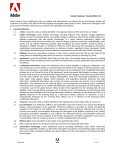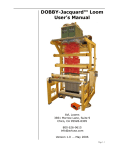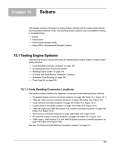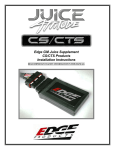Download F5M6J19G217AA
Transcript
*F5M6J19G217AA* 5M6J-19G217-AA May 2004 First Printing Quick Reference Guide Ford Motor Company Customer Relationship Center P.O. Box 6248 Dearborn, MI 48121 1-800-392-3673 (FORD) (TDD for the hearing impaired: 1-800-232-5952) This Quick Reference Guide is not intended to replace your vehicle Owner’s Guide which contains more detailed information concerning the features of your vehicle, as well as important safety warnings designed to help reduce the risk of injury to you and your passengers. Please read your entire Owner’s Guide carefully as you begin learning about your new vehicle and refer to the appropriate sections when questions arise. All information contained in this Quick Reference Guide was accurate at the time of duplication. We reserve the right to change features, operation and/or functionality of any vehicle specification at any time. Your Ford dealer is the best source for the most current information. For detailed operating and safety information, please consult your Owner’s Guide. MANUAL HEATING & AIR CONDITIONING SYSTEM 1 3 5 810 24 6 79 11 1 Fan Speed Control: Rotate the knob to adjust the speed of air that is circulated in the vehicle. 7 Panel and Floor: Distributes outside air through the instrument panel registers and floor vents. 2 Max A/C: With the climate system set to MAX A/C or defrost, the engine will run continuously, reducing fuel economy. 8 Floor: Distributes outside air through the floor vents only. 3 Recirculated Air: Recirculated air flows from the instrument panel vents to cool the vehicle. 4 A/C: Outside air flows from the instrument panel vents to cool the vehicle. When A/C mode is selected with the engine running, you may notice the air temperature cycle from cooler to warmer as the gas engine turns on and off. When in electric mode, the air will still blow, but the temperature may vary. 5 Panel: Distributes outside air through the instrument panel vents only. 6 Off: Outside air is shut out and the climate control system is turned off. 9 Floor and Defrost: Distributes outside air through the windshield defroster vents and the floor vents. This feature will cause the gas engine to run continuously, reducing fuel economy. 10 Defrost: Distributes outside air through the windshield defroster vents. With the climate system set to defrost mode, the engine will run continuously, reducing fuel economy. 11 Temperature Control: Rotate the knob to adjust the temperature of the airflow inside the vehicle. HYBRID ENERGY FLOW WITH AUDIOPHILE AND NAVIGATION 24 6 13 5 1 AM/FM: Pressing AM/FM in navigation mode will return the system to the audio screen. 2 Fuel Economy Function: Press to view average and instantaneous fuel economy screen. 3 Seek: Use to find next/previous listenable radio station or to advance tracks, if in CD mode. 4 HOME: Press and hold HOME key to store current vehicle location as home. Pressing HOME after the home location has been set will calculate a route to return to that set home location when in navigation mode. 5 Energy Flow Function: Press for status of engine and battery. To disengage, press the control again. Your energy flow screen displays how power is used and transferred between the electric motor, the high voltage battery, and the gasoline engine. It also indicates which mode you are currently operating in. Please see your Owner’s Guide for more information. 7 (if equipped) 9 11 8 10 6 Current Location: Press for information on current location. 7 Memory Presets: Stores favorite AM/FM stations and allows CD access when in CD mode. To store, press and hold until PRESET SAVED appears in display. 8 Navigation: Press NAV to access the navigation system menu. Make sure the vehicle is in Park (P) before you enter a destination. 9 MAP: The control works in all modes. Press MAP to show current location. 10 Back: Works only in navigation mode. Press to return to previous screen 11 ENTER: Use ENTER to view a menu in the navigation system. Press the control up, down, left, or right to highlight an item in the display. Press the center of the control to make selection. NOTE: With this system, the Six CD Changer is located under the passenger seat. SIX CD CHANGER (if equipped) 2 1 4 3 5 6 7 8 9 1 AM/FM and CD Select: In radio mode, press AM/FM to select AM or FM frequency bands. In CD mode, press AM/FM to stop play and begin radio play. To begin CD play while in radio mode, press the CD control. Automatic Volume Control: (if equipped) This audio system has speed sensitive volume control. Press and hold the volume control for five seconds; press the SEL control to increase or decrease volume levels. 2 CD/AUX: Press to select CD/AUX modes. No CD will display if there is not a CD present in the audio system. If a disc is loaded, there will be a number (1-6) inside the circle on the display. 6 Disc / Tune CAT: In radio mode, press to move to the next frequency up or down the band. In CD mode, press to select a disc in the CD player. CAT is only available when equipped with satellite radio. The kit to enable satellite reception is available through your Ford dealer. Detailed satellite instructions are included with the dealer-installed kit. 3 Loading CD: Press to open the CD door, then load the CD into the player. Press LOAD and then a preset number to select a slot. Press and hold LOAD to activate autoload. In radio mode, press to begin CD play. 4 Scan Function: In radio mode, press to hear a sampling of all listenable stations. In CD mode, press to hear a brief sampling of all selections on the current CD. 5 Volume / Power Control: Push the control to turn the audio system on or off. Turn the control to raise or lower volume. 7 Setting Memory Preset Stations: Select AM, FM1, or FM2 band, then select a station. Next, press and hold a control until the sound returns. 8 Digital Signal Processing (DSP): Press DSP and then SEL to choose the desired signal mode (NEWS, JAZZ CLUB, etc). 9 Setting the Clock: Press MENU until SELECT HOUR or SELECT MINS is displayed. Press SEL to set the time. Press MENU again to disengage the clock mode. Essential Information > Fuel Tank Capacity: Your vehicle is equipped with a 15-gallon fuel tank. Octane Recommendations: Your vehicle is designed to use “Regular” unleaded gasoline with pump octane rating of 87 for optimum performance. Using gasoline with lower octane ratings may decrease performance. Tire Pressure: Your tire pressure is properly set at the dealership according to the recommended specifications found on the Certification Label located on the driver’s side front door latch pillar. Tire pressure information can also be found on the Tire Information Label on the inside of the fuel filler door. Please check your tire pressure during routine maintenance and seasonal changes. WARNING: Improperly inflated tires can affect vehicle handling and can fail suddenly, resulting in a possible loss of vehicle control. Special Service Notes: This vehicle has unique service intervals — please check your Owner’s Guide for proper service intervals. Your vehicle is equipped with a rear air filter that must be inspected or replaced at every service interval to avoid damage to the hybrid system. Special caution is required when servicing brake pads. Please refer to the Owner’s Guide and/or Service Manual for information on servicing brake pads. Fuel Pump / High Voltage Shut-off Switches: Located in the front passenger’s footwell behind the flip-up cover and in the rear passenger side of the vehicle in the jack compartment behind the jack access door. These switches provide added protection by shutting off power to the high voltage battery and discontinuing fuel to the engine in case of an accident. 2005 FORD Escape Hybrid THE FORD ESCAPE HYBRID is 100% SUV and 100% Hybrid. It requires no special fuels and never has to be plugged in. All you have to do is get in and drive. With all the confidence of an authentic Ford SUV combined with the benefits of a full hybrid system, every Ford Escape Hybrid is equipped to help you go anywhere and do anything — now more efficiently than ever and in an environmentally conscious manner. In order to help you fully appreciate the features of your new vehicle and its unique characteristics, we invite you to explore this easy-to-use Quick Reference Guide. This vehicle has unique driving characteristics to maximize its hybrid operation. Drive with care and wear a seatbelt at all times. Ford urges you to read the Owner’s Guide and the Driving Your SUV or Truck Supplement for further information on safe driving precautions and instructions. Hybrid Operation > The Ford Escape Hybrid is a w without compromise to provide breakthrough performance and Familiarizing yourself with these unique characteristics will en Normal Vehicle Operation Starting: Turn the ignition key on while the vehicle is in Park (P). The gas engine will turn on, but may shut off shortly after starting, depending on temperature and battery state of charge. This is a natural part of the Escape Hybrid's fuel-saving features. You do not need to restart the vehicle. NOTE: If the vehicle is left inoperative for over 31 days — it may (but probably won’t) be necessary to jump-start the vehicle. Your Escape Hybrid is equipped with a high voltage battery jump-start feature in addition to the traditional 12V system. Consult your Owner’s Guide for jump-start instructions. Driving: The gas engine automatically starts and stops to provide power when it's needed and to save fuel when it's not. While coasting at low speeds, idling, or coming to a stop, the gas engine typically shuts down to conserve fuel and the vehicle will operate in electric-only mode. The gas engine will kick in upon acceleration. Conditions that cause the engine to start up include: n n n n n Battery recharge required Driver acceleration demands additional power Overly hot or cold outside temperature, or if the battery is overly hot or cold, the engine may engage sooner than usual Ascending a hill, accelerating quickly, or when driving conditions require additional power The gasoline engine will not shut off if the climate control is set to MAX A/C or defrost mode Stopping: The gas engine may shut off as you come to a stop to conserve fuel. Restarting the vehicle is not required. Simply step on the accelerator when you are ready to drive. Transmission Operation: Due to the technologically advanced, Electronically Controlled Continuously Variable Transmission (eCVT) you will not feel shift changes like those of a traditional vehicle. The Escape Hybrid's transmission is designed to do its work seamlessly. Neutral: It is not recommended to idle the vehicle in Neutral (N) for extended periods of time because this will discharge your hybrid battery system. Low Gear: Slowing down in Low (L) gear may cause a sensation of engine braking during deceleration. Response during acceleration should be the same as in Drive (D) position. Reverse: Reverse (R) gear vehicle speed is limited to 22 mph (35 km/h) until shifted to a non-reverse gear. In most cases, the vehicle will operate in electric-only mode while in Reverse (R). whole new kind of SUV that combines electric and gasoline propulsion d efficiency. It requires no special fuels and never has to be plugged in. nsure optimal performance from your new vehicle. Unique Hybrid Operating Characteristics Driving to Optimize Fuel Economy Battery: The Ford Escape Hybrid is equipped with a battery temperature management system in the rear of the vehicle. This system cools the battery in order to ensure battery life and optimize battery performance. You may hear a slight tap sound as the vent door operates. In addition, you may hear a fan noise in the rear of the vehicle. This is the temperature management fan. These noises are a customary part of hybrid operation and do not require service. The hybrid battery may go through a self–reconditioning process from time-to-time to optimize battery performance. You may notice slight changes in drivability during the reconditioning process. This is an important part of the Escape Hybrid's battery optimizing features. As with any vehicle, fuel economy can be significantly impacted by your driving habits and accessory usage. To maximize fuel economy, try to extend the length of time you run in electric mode by lightly accelerating the vehicle. The longer you keep the engine from starting, the better the fuel economy you will achieve. Engine: The engine speed in a hybrid is not directly tied to the vehicle speed. Under certain conditions the engine speed, as indicated on the tachometer while driving, may appear much higher than that of a conventional automobile. This is caused by engine speed optimization to maximize fuel economy. In prolonged mountainous driving, you may also see the engine tachometer slowly moving up and down. This is done to maintain the battery. You may also hear a slight whine or whistle when operating your vehicle. This is the normal operation of the electric generator in the hybrid system. If your 12V battery should become disconnected, you may experience engine spin for 3-5 seconds after the key is turned to the OFF position, for the next key cycle only. The computer is relearning the start up characteristics of your vehicle. Please be aware of the following vehicle functions which reduce fuel economy performance: Tire Inflation: Keep tires properly inflated and use only recommended size. Climate Control: With the climate control system set to MAX A/C, defrost and defrost/floor mode (the orange graphics on your climate control), the gas engine will run continuously, reducing fuel economy. The A/C mode is more fuel-efficient than the MAX A/C mode. Driver Habits: Rapid starts (jackrabbit starts), towing, and heavy loads all impact the amount of energy required to move the vehicle. In general, better fuel economy is achieved during moderate acceleration and deceleration, as opposed to aggressive acceleration and deceleration. This is true regardless of the mode in which you're operating. n n n n n Do not carry extra loads Do not decrease aerodynamics Use speed control Observe posted speed limits Keep engine tuned INSTRUMENT PANEL 10 1 2 34 5 6 7 8 9 11 3 1213 15 14 16 17 Instrument Panel Features > 1 Fog Lamp Control: Press the control to activate the fog lamps during headlamp operation. Press the control again to deactivate the fog lamps. The fog lamps will not operate when the high beams are activated. 2 Power Side View Mirrors: Rotate clockwise to adjust the right mirror or counterclockwise to adjust the left mirror. Then, move the control in the direction you wish to tilt the mirror. Return the control to the center position to lock the mirror in place. To adjust the power side view mirrors, ignition must be in the RUN position. 3 Speed Control: To operate, the speed control must be ON and the vehicle’s speed must be over 30 mph (48 km/h). To set a speed, press SET ACC. To set a higher speed, press SET ACC again. To set a lower speed, press CST. Pressing RESUME will return to the previously set speed. To disengage the speed control, press the OFF button or depress the brake pedal. 4 ABS Warning Lamp: Illuminates briefly when ignition is turned to the RUN position. If the light remains on for more than a few seconds, an ABS fault is indicated. Normal braking is still functional unless the brake warning light is also illuminated. 5 Battery Gauge: The battery gauge provides information about your vehicle’s energy usage. When the pointer is directed at ASSIST, this means the battery is providing extra power to boost the vehicle’s acceleration. When it’s pointing to CHARGE, extra energy is being stored in the battery while idling, coasting or slowing down. When you press the brake pedal, the pointer swings counterclockwise into the CHARGE zone to report that regenerative braking is underway. If the needle does not move when braking, the battery is fully charged. 6 Tachometer: Engine RPMs are indicated by the tachometer. The pointer will move into the green zone to show that the vehicle is in electric mode. When the vehicle operates in pure electric mode, the tachometer pointer drops below the zero mark where it points at a special symbol labeled EV for electric vehicle. Driving with your tachometer pointer continuously at the top of the scale may damage the engine. 7 Message Center: When the ignition is in the RUN position, the Message Center in your vehicle’s instrument cluster will display information on your vehicle’s operating functions as well as warning messages. There are two selectable features, located on the center console, for your Message Center: SET and INFO. SET is used to select and reset various functions shown in the INFO menu and INFO displays a menu which consists of average fuel economy (if equipped), distance to empty, instantaneous fuel economy (if equipped), battery SOC/Energy available, units (english/metric), language, system check and INFO display on/off. 8 Tilt Steering Wheel Lever: Push the tilt steering wheel lever downward to unlock the steering wheel. Then move the steering wheel up or down. Pull the lever up into the original position to lock the steering wheel. Never adjust the steering wheel while the vehicle is moving. 9 Ready Indicator: Illuminates after the vehicle has successfully started. The vehicle is ready to drive even if you don't hear the engine running. 10 Service Soon: Illuminates when the vehicle has detected a malfunction. Report the fault to your Escape Hybrid certified dealer at the earliest opportunity. 11 Master Electrical Hazard Warning Lamp: Indicates a major hybrid component failure or other major vehicle failure that will cause the vehicle to shut down or fail to start. Please see your Owner’s Guide for additional information. 12 Service Engine Soon Lamp: Illuminates briefly when ignition is turned to the RUN position. Solid illumination after start indicates the on board diagnostics system has detected a malfunction. Have your vehicle serviced immediately at an Escape Hybrid certified dealer. 13 Front and Rear Wiper / Washer Control: Front: Move the control down one position for intermittent operation. Rotate the speed control up for fast intervals and down for slow intervals. Move the control down two positions from OFF for normal or low-speed wiper operation. Move the control down three positions from OFF for high-speed wiper operation. Pull the control toward you to activate the windshield washer. Release the control to stop washer fluid spray. Move the control up and release for one wipe with mist. Rear: Rotate the end of the control upward to the INT position for intermittent operation. Adjust the speed control for fast or slow intervals. Rotate the control upward to ON for normal-speed operation. Rotate the control down one position and release to activate the rear washer. 14 Power Point (12V): The 12V power point outlet, located to the left of the 110 VAC outlet, is designed for accessory plugs only. Do not insert any other object; damage will occur and blow the fuse. This power outlet will require an adapter in order to plug in an electric device. 15 Rear Window Defroster Control: Push to clear the rear window of thin ice and frost. The rear window defroster control has an auto time-out feature that will electronically turn the system off after 15 minutes. If the heated rear window is still in operation when the ignition is switched off, the heating function will be reactivated when the ignition is switched on again. 16 Power Point (110 VAC): This outlet, located on the center console in front of the gearshift, is used for powering electrical devices that require up to 150W. Exceeding this limit will cause the power point to cut off the power temporarily to provide overload protection. The green indicator light will illuminate when the power point is ready to supply power, blink when it is in fault mode, and turn off when the power supply is off (ignition is not in the RUN position). This outlet does not require an adapter in order to plug in an electrical device. 17 Passenger Airbag Off: The passenger airbag off indicator, located just below the radio, will illuminate when the passenger’s frontal airbag is off. Please see your Owner’s Guide for additional information.












